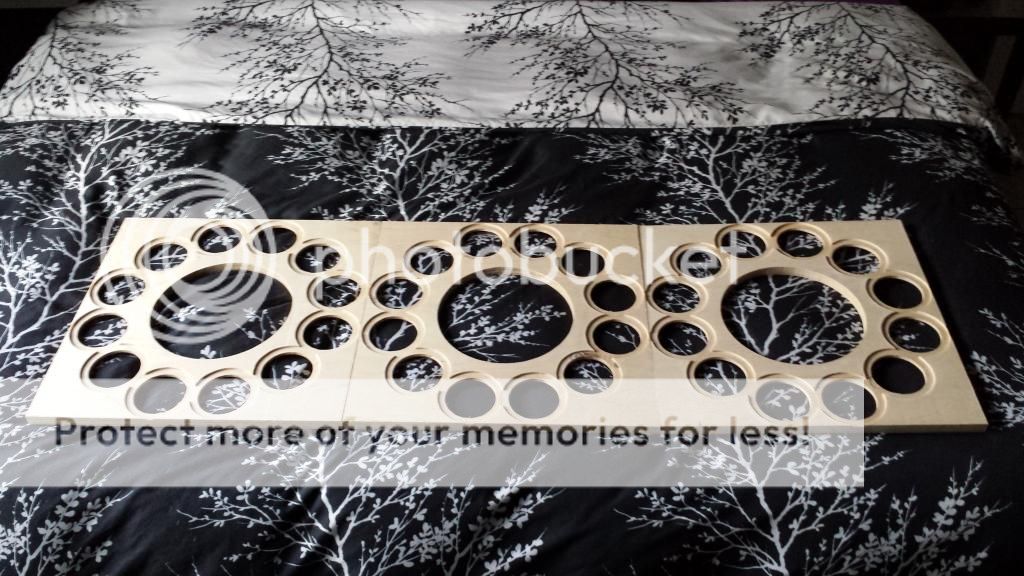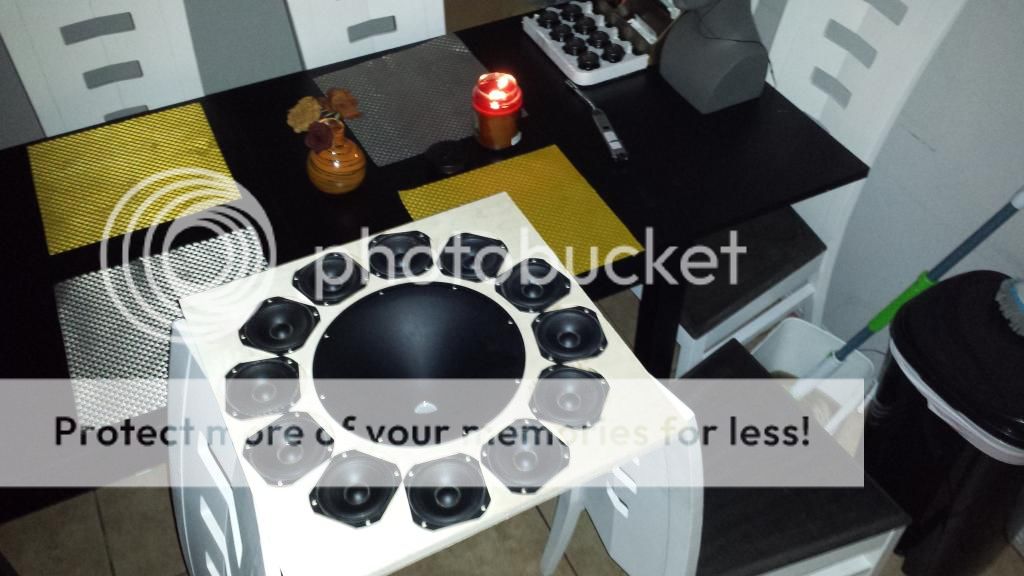Well, i do have walls. On both sides.
There is just a big opening t the kitchen.
Its ok I have a listening room as well.
This is an experiment so I'm going to build it this way first. I can put it in different rooms to hear how it sounds.
If I have a specific need to keep it in my theater room than i can decide to make 3 seperate boxes.
There is just a big opening t the kitchen.
Its ok I have a listening room as well.
This is an experiment so I'm going to build it this way first. I can put it in different rooms to hear how it sounds.
If I have a specific need to keep it in my theater room than i can decide to make 3 seperate boxes.
An equilateral triangle like that would be 30° from parallel with the side wall (or lack thereof), and 60° from parallel with front wall. or are these speakers supposed to be angled 45° toward each other? If the latter, I imagine it would be pretty much equivalent to something horizontally-omni. If straight ahead like shown below... beats me.
Attachments
Last edited:
Well, i do have walls. On both sides.
There is just a big opening t the kitchen.
Its ok I have a listening room as well.
Opening may not matter, if it does not swallow the main reflection. Let's say, if your room has a rectangular stub starting from the front wall it may be enough already for the concept to work succesfully.
An equilateral triangle like that would be 30° from parallel with the side wall (or lack thereof), and 60° from parallel with front wall. or are these speakers supposed to be angled 45° toward each other? If the latter, I imagine it would be pretty much equivalent to something horizontally-omni. If straight ahead like shown below... beats me.
No, it's only one speaker in the middle.
Not a stereo pair.
Ok Elias.
Cool.
This is more of an experiment to try and improve upon what has been done.
I want to see if controled dispersion along with active dsp where everything is controlled.
Along with the new dispersion pattern can improve things.
Cool.
This is more of an experiment to try and improve upon what has been done.
I want to see if controled dispersion along with active dsp where everything is controlled.
Along with the new dispersion pattern can improve things.
Ohhh yeah, sorry I don't know how I forgot the point so quickly. Placed 45° straight out of a corner (a good way into the room) might be worth a try too, then.No, it's only one speaker in the middle.
Not a stereo pair.
😡
Everytime I think up of something interesting, you guy's just have to suck the jelly out of my doughnut!
Everytime I think up of something interesting, you guy's just have to suck the jelly out of my doughnut!
I think what is so interesting about this concept is that it may have close to steady amplitude at nearly all frequencies due to the waveguides, I was going to do the 90 degree side firing L & R but I was researching off axis response of waveguides (the one I'm using particularly) and they are down 6 db at 60 degrees which is the reason for the triangular shape.
Then from that came other advantages such as the width of stereo effect in accordance with distance from the wall, also, the box should have more internal integrity because there will be no standing waves due to the shape.
Then I thought of doing the usual waveguide over woofer but I wanted to try and resolve the vertical lobing problem.
So I thought i would try the small drivers encircling the waveguide. (this is a scary proposition, considering the lobing that may occur)
But......
This may add to the controled dispersion by using the lobing by reducing amplitude off axis.
Thank goodness I'm doing this with dsp. It will be much easier to tinker with the crossover and slopes to try and achieve this.
Then from that came other advantages such as the width of stereo effect in accordance with distance from the wall, also, the box should have more internal integrity because there will be no standing waves due to the shape.
Then I thought of doing the usual waveguide over woofer but I wanted to try and resolve the vertical lobing problem.
So I thought i would try the small drivers encircling the waveguide. (this is a scary proposition, considering the lobing that may occur)
But......
This may add to the controled dispersion by using the lobing by reducing amplitude off axis.
Thank goodness I'm doing this with dsp. It will be much easier to tinker with the crossover and slopes to try and achieve this.
What about 3 good coaxials like a B&C 8inch. About the same price and the coax gets rid of your lobing issue.
RESTOCKED B&C 8CX21 8" Professional Coaxial Speaker 100 x 100 8 Ohm
RESTOCKED B&C 8CX21 8" Professional Coaxial Speaker 100 x 100 8 Ohm
Yeah, I've thought about coaxials of course but they don't seem to measure well usually because of the throat entry or because it's a moving waveguide.
I was actually going to try the kef's but they were a little small.
But who knows, maybe I'll try the Eminence 10"ers
You know I already have all these vifa's so I wanted to give this a go first.
The dayton waveguides were only 12 bucks each so what the heck.
I was actually going to try the kef's but they were a little small.
But who knows, maybe I'll try the Eminence 10"ers
You know I already have all these vifa's so I wanted to give this a go first.
The dayton waveguides were only 12 bucks each so what the heck.
Then from that came other advantages such as the width of stereo effect in accordance with distance from the wall, also, the box should have more internal integrity because there will be no standing waves due to the shape.
I don't think you will get very good stereo from the speaker as it is planned now. See, the arrival time difference between the direct sound (L+R) and the rear signals (L and/or R) at the listening position is likely going to be too long.
 There is a limit after which the precedence effect cannot be broken down anymore. It looks like you are stepping beyond that limit with this design.
There is a limit after which the precedence effect cannot be broken down anymore. It looks like you are stepping beyond that limit with this design. It is likely that what will be heard is the sound at the center all the time, plus some additional 'reverberance', but there will not be stereo effect like that of panning in the stereo recordings.
At the end you may consider angling the side drivers at 45 degrees from the front, like Nagaoka did. Since horns are quite directive, it may be better to angle 45, instead of 90. I was using small drivers at the 90 degrees side, but they had wide directivity.
If you still want to try it as planned, I am looking forward for your listening impressions, of course 🙂
.
Thanks Elias.
I really appreciate your input.
I can delay the center channel.
What do you think of that?
I really appreciate your input.
I can delay the center channel.
What do you think of that?
Here's a dumb 'trick' that may be helpful to you and Elias.
When working on my Sausalito Audio Works lenses, I noticed that the reflection off the wall was virtually identical to the on-axis sound, but attenuated.
Due to that, you can tweak the gates on your measurement so that you're equalizing the reflection, not the initial wavefront.
When you do that, you're basically treating the reflection off of the wall as if there's a speaker there. Basically ignore the sound radiated by the loudspeaker, and focus on the reflection.
Obviously, this means that you can't move the speaker once it's EQ'd! But since we have measurement gear and we're building the speaker solely for our own room, we have that luxury.
When working on my Sausalito Audio Works lenses, I noticed that the reflection off the wall was virtually identical to the on-axis sound, but attenuated.
Due to that, you can tweak the gates on your measurement so that you're equalizing the reflection, not the initial wavefront.
When you do that, you're basically treating the reflection off of the wall as if there's a speaker there. Basically ignore the sound radiated by the loudspeaker, and focus on the reflection.
Obviously, this means that you can't move the speaker once it's EQ'd! But since we have measurement gear and we're building the speaker solely for our own room, we have that luxury.
- Status
- Not open for further replies.
- Home
- Loudspeakers
- Multi-Way
- The Portal....a controlled dispersion tripole






